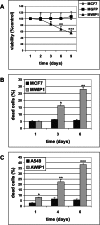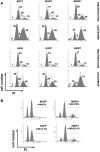Down-regulation of wild-type p53-induced phosphatase 1 (Wip1) plays a critical role in regulating several p53-dependent functions in premature senescent tumor cells
- PMID: 23612976
- PMCID: PMC3675561
- DOI: 10.1074/jbc.M112.435149
Down-regulation of wild-type p53-induced phosphatase 1 (Wip1) plays a critical role in regulating several p53-dependent functions in premature senescent tumor cells
Abstract
Premature or drug-induced senescence is a major cellular response to chemotherapy in solid tumors. The senescent phenotype develops slowly and is associated with chronic DNA damage response. We found that expression of wild-type p53-induced phosphatase 1 (Wip1) is markedly down-regulated during persistent DNA damage and after drug release during the acquisition of the senescent phenotype in carcinoma cells. We demonstrate that down-regulation of Wip1 is required for maintenance of permanent G2 arrest. In fact, we show that forced expression of Wip1 in premature senescent tumor cells induces inappropriate re-initiation of mitosis, uncontrolled polyploid progression, and cell death by mitotic failure. Most of the effects of Wip1 may be attributed to its ability to dephosphorylate p53 at Ser(15) and to inhibit DNA damage response. However, we also uncover a regulatory pathway whereby suppression of p53 Ser(15) phosphorylation is associated with enhanced phosphorylation at Ser(46), increased p53 protein levels, and induction of Noxa expression. On the whole, our data indicate that down-regulation of Wip1 expression during premature senescence plays a pivotal role in regulating several p53-dependent aspects of the senescent phenotype.
Keywords: Cancer; Cell Death; Cellular Senescence; DNA Damage Response; Polyploidy; Wip1; p53.
Figures









Similar articles
-
Wild-type p53-induced phosphatase 1 (Wip1) forestalls cellular premature senescence at physiological oxygen levels by regulating DNA damage response signaling during DNA replication.Cell Cycle. 2014;13(6):1015-29. doi: 10.4161/cc.27920. Epub 2014 Jan 31. Cell Cycle. 2014. PMID: 24552809 Free PMC article.
-
Oncogenic Wip1 phosphatase is inhibited by miR-16 in the DNA damage signaling pathway.Cancer Res. 2010 Sep 15;70(18):7176-86. doi: 10.1158/0008-5472.CAN-10-0697. Epub 2010 Jul 28. Cancer Res. 2010. PMID: 20668064 Free PMC article.
-
Cooperation of Nutlin-3a and a Wip1 inhibitor to induce p53 activity.Oncotarget. 2016 May 31;7(22):31623-38. doi: 10.18632/oncotarget.9302. Oncotarget. 2016. PMID: 27183917 Free PMC article.
-
Control of p53 and NF-κB signaling by WIP1 and MIF: role in cellular senescence and organismal aging.Cell Signal. 2011 May;23(5):747-52. doi: 10.1016/j.cellsig.2010.10.012. Epub 2010 Oct 16. Cell Signal. 2011. PMID: 20940041 Review.
-
Regulation of the Wip1 phosphatase and its effects on the stress response.Front Biosci (Landmark Ed). 2012 Jan 1;17(4):1480-98. doi: 10.2741/3999. Front Biosci (Landmark Ed). 2012. PMID: 22201816 Free PMC article. Review.
Cited by
-
Wild-type p53-induced phosphatase 1 (Wip1) forestalls cellular premature senescence at physiological oxygen levels by regulating DNA damage response signaling during DNA replication.Cell Cycle. 2014;13(6):1015-29. doi: 10.4161/cc.27920. Epub 2014 Jan 31. Cell Cycle. 2014. PMID: 24552809 Free PMC article.
-
Prevention of BMS-777607-induced polyploidy/senescence by mTOR inhibitor AZD8055 sensitizes breast cancer cells to cytotoxic chemotherapeutics.Mol Oncol. 2014 May;8(3):469-82. doi: 10.1016/j.molonc.2013.12.014. Epub 2014 Jan 2. Mol Oncol. 2014. PMID: 24444656 Free PMC article.
-
Protein phosphatase 5 and the tumor suppressor p53 down-regulate each other's activities in mice.J Biol Chem. 2018 Nov 23;293(47):18218-18229. doi: 10.1074/jbc.RA118.004256. Epub 2018 Sep 27. J Biol Chem. 2018. PMID: 30262665 Free PMC article.
-
Gamma-H2AX upregulation caused by Wip1 deficiency increases depression-related cellular senescence in hippocampus.Sci Rep. 2016 Sep 30;6:34558. doi: 10.1038/srep34558. Sci Rep. 2016. PMID: 27686532 Free PMC article.
-
Role of wild-type p53-induced phosphatase 1 in cancer.Oncol Lett. 2017 Oct;14(4):3893-3898. doi: 10.3892/ol.2017.6685. Epub 2017 Jul 27. Oncol Lett. 2017. PMID: 28959360 Free PMC article.
References
-
- Hayflick L., Moorhead P. S. (1961) The serial cultivation of human diploid cell strains. Exp. Cell Res. 25, 585–621 - PubMed
-
- Wang Y., Blandino G., Oren M., Givol D. (1998) Induced p53 expression in lung cancer cell line promotes cell senescence and differentially modifies the cytotoxicity of anti-cancer drugs. Oncogene 17, 1923–1930 - PubMed
-
- Wang Y., Blandino G., Givol D. (1999) Induced p21waf expression in H1299 cell line promotes cell senescence and protects against cytotoxic effect of radiation and doxorubicin. Oncogene 18, 2643–2649 - PubMed
-
- Chang B. D., Broude E. V., Dokmanovic M., Zhu H., Ruth A., Xuan Y., Kandel E. S., Lausch E., Christov K., Roninson I. B. (1999) A senescence-like phenotype distinguishes tumor cells that undergo terminal proliferation arrest after exposure to anticancer agents. Cancer Res. 59, 3761–3767 - PubMed
Publication types
MeSH terms
Substances
LinkOut - more resources
Full Text Sources
Other Literature Sources
Molecular Biology Databases
Research Materials
Miscellaneous

